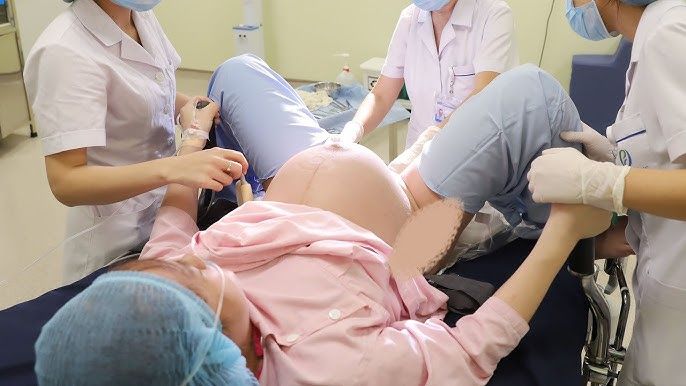
The second stage of labor, often referred to as the “pushing stage,” is a critical phase extending from full cervical dilation (10 centimeters) until the birth of the baby. It is a period of intense maternal effort and requires vigilant monitoring and skillful management by healthcare professionals to ensure the safety and well-being of both the mother and the fetus.
Definition and Onset Recognition
What it is: The second stage of labor is the period during which the baby descends through the birth canal and is delivered. It is characterized by involuntary uterine contractions, often accompanied by a strong urge to bear down.
How to recognize onset: The definitive sign is full cervical dilation (10 cm) and complete effacement (100%), confirmed by a vaginal examination. Other indicators may include:
- An uncontrollable urge to push.
- Changes in maternal breathing, often becoming more primal or grunty.
- Increased show (blood-tinged mucus).
- Bulging of the perineum.
Phases of the Second Stage
The second stage is often divided into two phases:
- Passive (Latent) Second Stage: This phase occurs after full dilation but before the mother feels an irresistible urge to push or before active pushing begins. It allows for further fetal descent with contractions alone, especially beneficial for mothers with epidural analgesia or those who are physically exhausted.
- Active (Descent) Second Stage: This phase begins when the mother feels an irresistible urge to push or when active pushing efforts commence.
Understanding these phases allows for individualized care, promoting rest and passive descent when appropriate, rather than immediately initiating directed pushing.
Comprehensive Maternal Assessment
Continuous assessment of the mother is paramount throughout the second stage.
- Vital Signs: Monitor maternal blood pressure, pulse, respiration, and temperature regularly (e.g., every 15-30 minutes, or more frequently if concerns arise) to detect signs of exhaustion, infection, or pre-eclampsia.
- Contraction Pattern: Assess frequency, intensity, and duration of uterine contractions. Effective contractions are powerful and regular, driving fetal descent.
- Maternal Well-being:
- Emotional State: Provide continuous emotional support, encouragement, and reassurance. Acknowledge her efforts and manage anxiety.
- Physical Exhaustion: Monitor for signs of fatigue. Offer sips of water or isotonic drinks, and encourage rest between contractions.
- Pain Management: Evaluate the effectiveness of existing pain relief (e.g., epidural). Adjust or offer alternative comfort measures as needed.
- Bladder Status: Ensure the bladder is empty to facilitate fetal descent. Encourage voiding or perform intermittent catheterization if necessary. A full bladder can impede descent.
Fetal Assessment and Monitoring
Fetal well-being is continually assessed to detect any signs of distress.
- Fetal Heart Rate (FHR) Monitoring:
- Low-Risk Pregnancies: Intermittent auscultation (IA) of the FHR every 5-15 minutes or after each contraction.
- High-Risk Pregnancies or Concerns: Continuous electronic fetal monitoring (CEFM) is typically indicated.
- Interpretation: Evaluate FHR for baseline, variability, accelerations, and decelerations. Any non-reassuring patterns require prompt intervention and further assessment.
- Fetal Position and Descent:
- Vaginal Examinations: Perform judiciously to assess fetal station (relationship of the presenting part to the ischial spines, reported as + or – cm), position (e.g., occiput anterior, posterior), and cervical changes. These also confirm progress of descent and rotation.
- Palpation: External palpation can help confirm fetal position and descent.
- Molding and Caput: Note the presence and degree of molding (overlapping of fetal skull bones) and caput succedaneum (swelling on the scalp) as indicators of pressure and descent.
Promoting Physiological Pushing and Maternal Positioning
Evidence-based care emphasizes supporting the woman’s natural urge to push and utilizing positions that aid descent.
- Spontaneous/Physiological Pushing: Encourage the mother to push when she feels an urge, allowing her to follow her body’s cues rather than directed pushing (Valsalva maneuver). This approach is associated with less maternal fatigue, less perineal trauma, improved fetal oxygenation, and better newborn outcomes.
- Guide her to take a deep breath, hold it for a few seconds (5-7 seconds), and push gently downwards into her perineum with each contraction.
- Encourage short, open-glottis pushes rather than prolonged breath-holding.
- Allow rest and recovery between contractions.
- Maternal Positioning: Promote upright, mobile, and gravity-assisted positions unless contraindicated.
- Upright Positions: Sitting, squatting, kneeling, or standing can utilize gravity to aid fetal descent and optimize the pelvic outlet.
- Lateral Position: Lying on her side can relieve pressure on the sacrum, increase pelvic diameter, and facilitate rotation of an occiput posterior baby.
- Hands-and-Knees (All Fours): Especially beneficial for back pain, facilitating rotation of an occiput posterior presentation, and reducing perineal pressure.
- Reclining Positions: If supine, ensure some degree of elevation and lateral tilt to avoid aortocaval compression. Avoid lying flat on the back.
- Support and Encouragement: Provide continuous verbal encouragement, guidance, and physical support. Remind her of her strength and progress.
Perineal Management and Preparation for Birth
Protecting the perineum while facilitating birth is a key aspect of care.
- Warm Compresses: Applying warm, moist compresses to the perineum during crowning can reduce perineal trauma, including the incidence of third and fourth-degree tears.
- Perineal Support: Gentle counter-pressure and manual support of the perineum as the head crowns can help control the rate of expulsion, allowing the perineum to stretch slowly.
- Episiotomy: Routine episiotomy is not recommended. It should be performed restrictively and only when clinically indicated (e.g., signs of fetal distress requiring rapid delivery, shoulder dystocia, or certain maternal conditions). If performed, it should be a mediolateral episiotomy with careful technique and informed consent.
- Communication: Clearly communicate with the mother about the progress of the head and the plan for pushing to facilitate controlled delivery.
Delivery of the Baby
This is the culmination of the second stage, requiring skilled hands for a gentle and controlled birth.
- Crowning: As the fetal head advances, it distends the perineum. Once the widest diameter of the head passes through the pelvic outlet without receding between contractions, this is crowning. Encourage small, gentle pushes or panting to control the delivery.
- Delivery of the Head: Support the perineum and fetal head. Allow the head to extend slowly. Check for nuchal cord immediately after the head is born. If present, attempt to slip it over the head, or double clamp and cut if tight or multiple loops.
- External Rotation: After the head delivers, it will usually rotate spontaneously to align with the fetal shoulders.
- Delivery of the Shoulders: Guide the mother to push gently for the anterior shoulder. Apply gentle downward traction to deliver the anterior shoulder, followed by gentle upward traction for the posterior shoulder. Avoid excessive force to prevent shoulder dystocia.
- Delivery of the Body: Once the shoulders are clear, the rest of the body usually follows quickly and smoothly.
- Timing: Note the time of birth, which marks the end of the second stage.
Immediate Post-Delivery Care
- Skin-to-Skin Contact: Place the newborn immediately on the mother’s abdomen for skin-to-skin contact, promoting warmth, bonding, and early breastfeeding initiation.
- Cord Clamping: Current recommendations suggest delayed cord clamping (waiting at least 1-3 minutes or until pulsations cease) for most healthy term and preterm infants, as it is associated with several benefits, including improved iron stores and reduced risk of intraventricular hemorrhage in preterm infants.
- Apgar Scores: Assess the newborn’s condition at 1 and 5 minutes post-birth.
- Newborn Identification: Apply identification bands immediately.
Documentation
Thorough and accurate documentation is essential for continuity of care and legal purposes. Record:
- Time of full dilation and onset of active pushing.
- Maternal vital signs, contraction pattern, and emotional state.
- FHR assessment and interventions.
- Maternal positions and pushing efforts.
- Perineal management (warm compresses, support, episiotomy if applicable).
- Fetal descent, rotation, and presentation.
- Time of birth, type of delivery (spontaneous vaginal, operative vaginal), and any complications.
- Immediate newborn care (Apgar scores, skin-to-skin, cord clamping time).
Conclusion
Managing the second stage of labor is a dynamic process that demands patience, skilled observation, and a profound understanding of physiological birth. By adopting an individualized, evidence-based approach that prioritizes spontaneous pushing, optimal maternal positioning, and vigilant monitoring of maternal and fetal well-being, healthcare professionals can significantly contribute to positive birth experiences and outcomes. The aim is always to support the natural progression of labor while being prepared to intervene safely and effectively when circumstances necessitate.
References
- American College of Obstetricians and Gynecologists (ACOG). (2014). Approaches to Limit Intervention During Labor and Birth. Committee Opinion No. 592. Obstet Gynecol, 123(3), 693-698. (Reaffirmed 2019).
- World Health Organization (WHO). (2018). WHO recommendations: Intrapartum care for a positive childbirth experience. World Health Organization.
- National Institute for Health and Care Excellence (NICE). (2017). Intrapartum care for healthy women and babies. Clinical guideline [CG190]. NICE.
- American Academy of Pediatrics (AAP) & American College of Obstetricians and Gynecologists (ACOG). (2017). Guidelines for Perinatal Care (8th ed.). Elk Grove Village, IL: AAP; Washington, DC: ACOG.
- Simkin, P., & Ancheta, R. (2011). The Labor Progress Handbook: Early Interventions to Prevent and Treat Dystocia. John Wiley & Sons.






